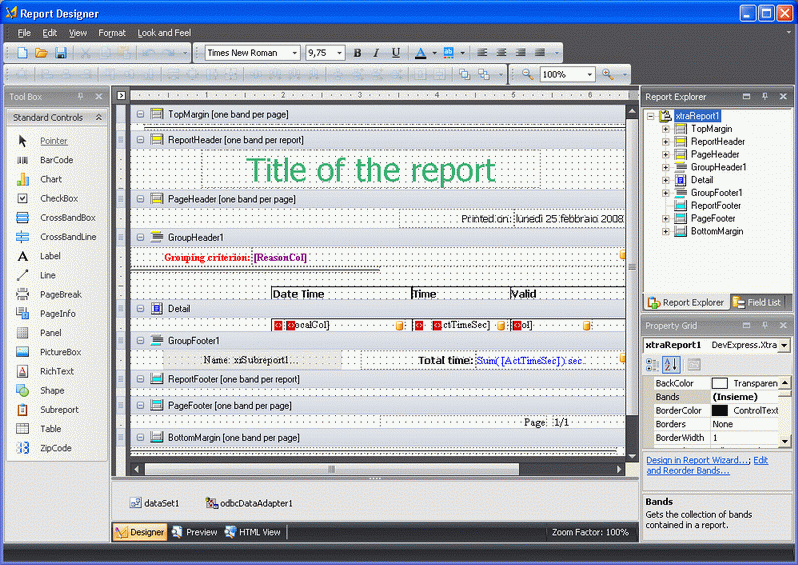
Movicon Help on Line - Rel. 11.7.1301
The Report Designer is an extremely powerful tool that has been integrated in Movicon for give users the possibility to automatically create reports relating to the Movicon databases, without having to purchase supplementary software packs. The Report Designer Libraries are therefore installed with Movicon totally free without needing you to enable any license options in order to use them.
The basic steps in creating a minimal report are briefly described below:
The Report Designer can be called through "Edit Report File" command found in the Data Logger or recipe properties of "Historical Log Windows" or "TraceDB Windows". In this case the Report Designer will open in edit mode:

The Report Designer opens showing its "Tool Box" on the left and the "Report Explorer", "Field List" and "Grid Property" on the right. The report Layout is in the centre.
By using the Movicon commands the report will open with the database connection already configured with the original object's data table fields listed in the "Field List" for reference (DataLogger/Recipe table variable TraceDB or Historical Log).
The report is composed of "Band" objects, which are inserted using the "Insert Band" command accessible with a right click on the report layout area. The Bands are:
Top Margin: one per page only. Represents the top limit of the report page.
Report Header: one per report only. The first thing printed and only on the first report page.
Page Header: page header and is printed at the top of every page.
Group Header: you can use more than one group header per report to represent the beginning of a data group.
Detail: contains the data to be shown.
Group Footer: closes a data group and always corresponds to a Group Header.
Report Footer: printed at the end of the report on the last page.
Page Footer: closes each report page.
Bottom Margin: one only per page. Represents the report page's bottom limit.
Only the Detail Band is needed to build a simple report. The fields you wish to display can be dragged from the "Field List" and when the report is executed these fields will show with all the records exiting in the table.
Filters
You can use the xtraReport object's Grid "FilterString" property (select the xtraReport in the Report Explorer Window). This property must contain the expression criteria (WHERE (Es. [col] > 0, where "col" is the name of a data table column).
Groups
You will need to insert a Group Header Band and use the "GroupFields" property for setting the second field to group data. You can also specify the data order in the same property.
Data Summary
The report can execute summaries (totals, counts, averages,..) on data groups. This is done by inserting a "Label" band, linked to a field from the Field List. The "Label's" "Summary" property allows you to set the summary type you wish to create using the dialog window which contains:
Bound field: name of field in which operation is to be executed
Summary function: operation type to be executed
Format string: format type for results where you can add measure units as text
Ignore NULL values: specifies whether or not to ignore NULL field value records
Summary Running: defines the environment in which to execute the operation. Obtains these values:
None = no calculation
Group = executed for all group members. This value resets at the beginning of the next group
Page = executed for the values presented on one page
Report = executed for all the values in the report